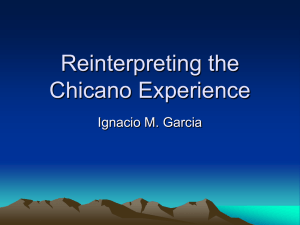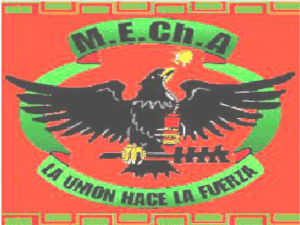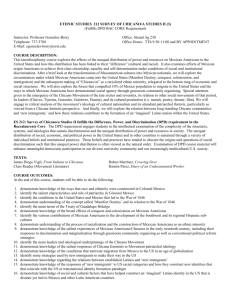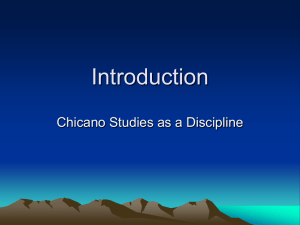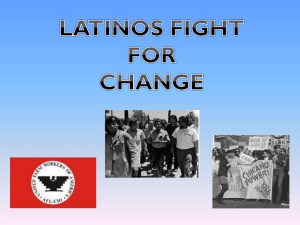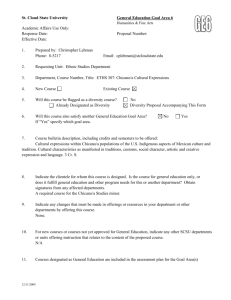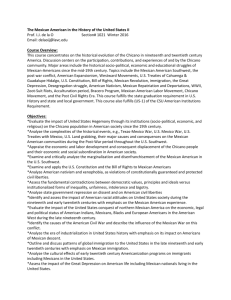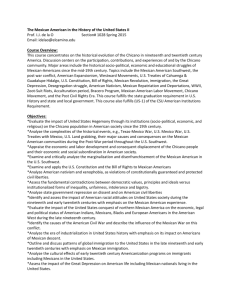A Mexican American Case Study Exploring the
advertisement
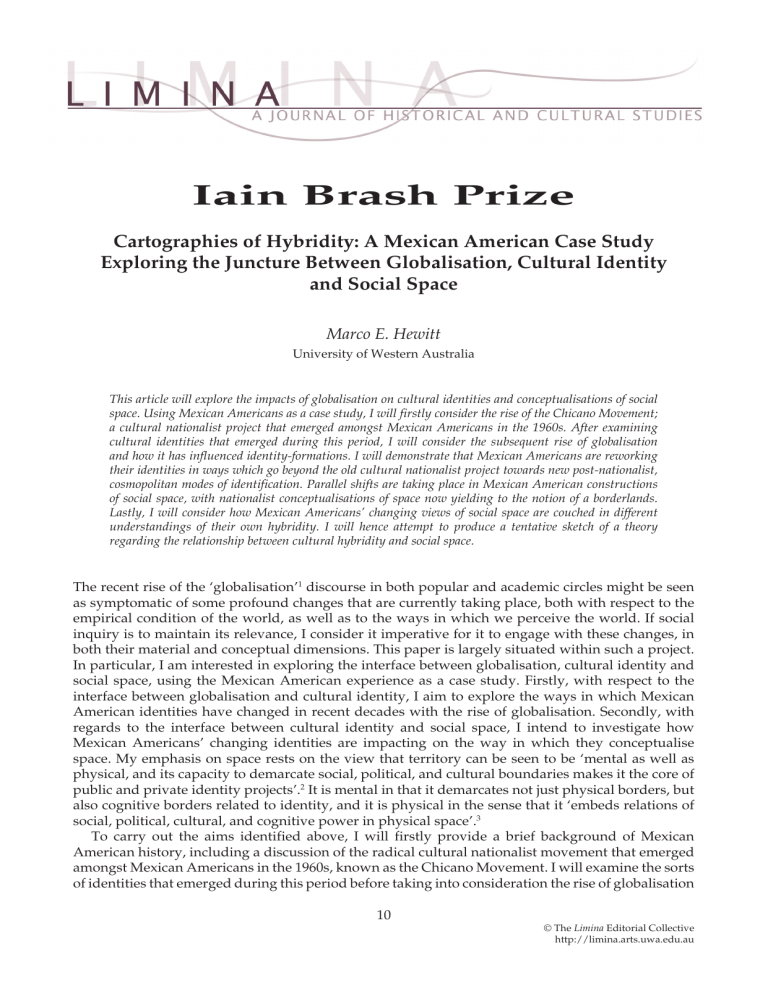
Limina, Volume 13, 2007 Marco E. Hewitt Iain Brash Prize Cartographies of Hybridity: A Mexican American Case Study Exploring the Juncture Between Globalisation, Cultural Identity and Social Space Marco E. Hewitt University of Western Australia This article will explore the impacts of globalisation on cultural identities and conceptualisations of social space. Using Mexican Americans as a case study, I will firstly consider the rise of the Chicano Movement; a cultural nationalist project that emerged amongst Mexican Americans in the 1960s. After examining cultural identities that emerged during this period, I will consider the subsequent rise of globalisation and how it has influenced identity-formations. I will demonstrate that Mexican Americans are reworking their identities in ways which go beyond the old cultural nationalist project towards new post-nationalist, cosmopolitan modes of identification. Parallel shifts are taking place in Mexican American constructions of social space, with nationalist conceptualisations of space now yielding to the notion of a borderlands. Lastly, I will consider how Mexican Americans’ changing views of social space are couched in different understandings of their own hybridity. I will hence attempt to produce a tentative sketch of a theory regarding the relationship between cultural hybridity and social space. The recent rise of the ‘globalisation’1 discourse in both popular and academic circles might be seen as symptomatic of some profound changes that are currently taking place, both with respect to the empirical condition of the world, as well as to the ways in which we perceive the world. If social inquiry is to maintain its relevance, I consider it imperative for it to engage with these changes, in both their material and conceptual dimensions. This paper is largely situated within such a project. In particular, I am interested in exploring the interface between globalisation, cultural identity and social space, using the Mexican American experience as a case study. Firstly, with respect to the interface between globalisation and cultural identity, I aim to explore the ways in which Mexican American identities have changed in recent decades with the rise of globalisation. Secondly, with regards to the interface between cultural identity and social space, I intend to investigate how Mexican Americans’ changing identities are impacting on the way in which they conceptualise space. My emphasis on space rests on the view that territory can be seen to be ‘mental as well as physical, and its capacity to demarcate social, political, and cultural boundaries makes it the core of public and private identity projects’.2 It is mental in that it demarcates not just physical borders, but also cognitive borders related to identity, and it is physical in the sense that it ‘embeds relations of social, political, cultural, and cognitive power in physical space’.3 To carry out the aims identified above, I will firstly provide a brief background of Mexican American history, including a discussion of the radical cultural nationalist movement that emerged amongst Mexican Americans in the 1960s, known as the Chicano Movement. I will examine the sorts of identities that emerged during this period before taking into consideration the rise of globalisation 10 © The Limina Editorial Collective http://limina.arts.uwa.edu.au Limina, Volume 13, 2007 Marco E. Hewitt from the early 1970s onwards and the massive impacts that it has had and continues to have on the formulation of identities. I will demonstrate that, with the rise of globalisation, Mexican American identities are being reworked in ways which go beyond the limits of the old cultural nationalist project towards new postnationalist and cosmopolitan modes of identification. With this shift in identity, I will demonstrate that a parallel shift has taken place in Mexican American constructions of social space, with nationalist conceptualisations of space now giving way to the notion of a borderlands. Lastly, I will consider how Mexican Americans’ changing identities and views of social space have been couched in different understandings of their own hybridity. Hence, I will ultimately attempt to produce a tentative sketch of a theory regarding the relationship between cultural hybridity and social space. Historical background Mexican Americans are today an integral part of the United States (US), especially in the Southwest. In California alone, they make up one-third of the population.4 Furthermore, they are not just products of immigration, but also of Anglo-American5 colonialism. In the US-Mexico War of 1846-48, the US conquered Mexico’s entire northern region; an area that includes present-day California, Arizona, New Mexico and Texas.6 After Native Americans, Mexican Americans are the oldest inhabitants of what today comprises the territory of the United States, with many still perceiving themselves as ‘a conquered people’.7 In contemporary US society, Mexican Americans are often the ‘invisible beasts of burden’,8 suffering not just from economic exploitation but also from day-to-day racism. If, as Jean-Paul Sartre claims, ‘anti-Semitism produces the Jew’,9 then similarly, it could be claimed that marginalisation and racism have been factors in the production of the Mexican American subject. Mexican Americans’ history of marginalisation, coupled with their hybrid existences, has consistently compelled them to struggle with their identity. Max Benavidez captures perfectly the identity dilemma faced by Mexican Americans: Not Native American, yet of the Indian. Not Spanish, yet of Europe. Not even Mexican in the strictest sense of the term. And the US-born Mexican is rarely, if ever, considered “American”.10 Mexican Americans live an extremely complex existence and are required to negotiate a huge range of identity labels. Guillermo Gómez-Peña explains: When they ask me my ethnicity, I cannot respond with one word, since my “identity” has multiple repertoires. I am Mexican but also Chicano and Latin American. On the border they call me “chilango” or “mexiquillo”; in the capital “pocho” or “norteño”, and in Europe “Sudaca”. AngloSaxons call me “Hispanic” or “Latino”.11 The ways in which Mexican Americans have negotiated their identities have changed over time. To demonstrate this, I will examine identities prevalent in the 1960s before comparing them with those of today. The 1960s saw the emergence of a radicalism never before seen amongst Mexican Americans. Their radicalisation arose in a highly politicised global climate, with national liberation movements in Africa and Asia, and the Black Civil rights movement at home, serving as inspirations.12 The Mexican American struggle for social justice and self-determination was an integral part of the wider insurgency in the US, and came to be known as the Chicano Movement. The term ‘Chicano’13 was a new oppositional identity-label adopted by Mexican Americans in the 1960s as a symbol of their new political assertiveness and cultural pride. Prior to the 1960s, ‘Chicano’ was considered highly pejorative, and had been used to refer to poor or undocumented Mexican migrants. The Chicano Movement reappropriated and recoded the term in what was a ‘highly politicized act of self-identification [and] … self-empowerment’.14 Chicanismo was the name given to the cultural nationalist ideology that came to form the backbone of the Chicano Movement. It was eagerly received by activists searching for a unifying 11 © The Limina Editorial Collective http://limina.arts.uwa.edu.au Limina, Volume 13, 2007 Marco E. Hewitt narrative to resist the ‘psychological colonization’ of US hegemony.15 One Mexican American activist commented: [N]ationalism is the key to our people liberating themselves … creating life amid death is a revolutionary act. Just as building nationalism in an era of imperialism is a life-giving act … we are an awakening people, an emerging nation, a new breed.16 Proponents of Chicanismo saw a common cause with other national liberation movements, and looked to Algeria and Cuba as inspirations. Regarding the Cuban Revolution and other Latin American struggles, Luís Valdez stated that ‘[t]he Mexican in the United States has been … no less a victim of American imperialism than his impoverished brothers [sic] in Latin America.’17 Proponents of Chicanismo were also inspired by the North Vietnamese struggle during the Vietnam War, believing that both Mexican Americans and Vietnamese suffered from ‘Anglo occupation’, and were fighting a common enemy.18 The Mexican American, ‘feeling deeply alienated from the foster parent United States, wished to maintain a vital spiritual link with Mexico’, according to Genaro Padilla.19 However, this spiritual link did not draw upon ‘official’ culture as propounded by the Mexican nation-state, but rather, was forged through an indigenous revivalism which appropriated pre-Colombian Aztec mythology. Through narratives of a heroic Aztec past, Mexican Americans ‘proposed a continuity between preCortesian20 indigenous society and contemporary Chicano/a socio-cultural identity’.21 Prior to Chicanismo, and the indigenous pride that it fostered, Mexican Americans had played down their Indian heritage. This was due to a hostile US environment which disseminated racist stereotypes of Indians and Mexicans. Mexicans were typecast as ‘the dirty Mexican, the greaser [or] … the bandido’, and Indians as the ‘uncivilized savage’.22 As late as 1960, one police officer commented: ‘[s]ome of them [Mexican Americans] are not far removed from the wild tribes of Mexico.’23 Many Mexican Americans internalised the racism they experienced, becoming ashamed of their heritage and consequently claiming to be ‘Spanish’ or ‘Spanish-American’.24 Chicanismo dramatically reversed this trend. It was the revival of the Aztec myth of Aztlán that was perhaps the key ideological maneuvre of Chicanismo. Aztlan: The Chicano Homeland The concept of ‘Aztlán’, as used in the context of the Chicano Movement, was formulated at the National Chicano Youth Liberation Conference in Denver in March 1969. This conference brought together hundreds of students, workers, street-gang youth and ex-convicts, to discuss the way forward for the Chicano Movement. It proved a huge success, with one participant describing it as a fiesta in which ‘a people, who, taught to believe they are ugly, discover[ed] the true beauty of their souls’.25 The great significance of the conference lay in the final document it produced, El Plan Espiritual de Aztlán (The Spiritual Plan of Aztlán).26 Composed by a committee of poets, this document soon became one of the defining texts of Chicanismo. Aztlán was an old Aztec myth which El Plan resurrected and recoded, and was the name the Aztecs used to refer to their original homeland. According to legend, the god Huitzilopochtli advised the Aztecs to leave Aztlán in search of a new ‘promised land’ which they would know by the sight of an eagle, sitting on a cactus, devouring a snake.27 A great southwards migration is believed to have taken place in the year 1168.28 Where the Aztecs chanced upon the prophetic eagle, a new city named Tenochtitlán29 was established around 1325, soon becoming the capital of their new empire.30 Later, the Aztecs ‘remembered the region of their origin as an earthly paradise’.31 In the fifteenth century, the emperor Moctezuma Ilhuicamina even sent an expedition party of priests in search of Aztlán. Aztlán of the Aztec myth has never been geographically pinpointed, being somewhat akin to the legend of Atlantis. Scholars are in disagreement as to whether it was located in the Great Lakes region, Florida, California, or even China.32 Chicano Movement activists, however, had their own ideas about its location. Since legend had it that the Aztecs had migrated to present-day Mexico 12 © The Limina Editorial Collective http://limina.arts.uwa.edu.au Limina, Volume 13, 2007 Marco E. Hewitt from ‘somewhere in the north’, Chicanismo conflated Aztlán with the Mexican territory conquered by the US in 1848.33 El Plan was novel in that, not only did it identify Aztlán as the Mexican territory conquered by the US, but it also linked, for the first time, the Chicano subject with Aztlán. The new homeland provided a ‘spiritual center’ which could galvanise Mexican Americans into action.34 In dramatic fashion, El Plan declared the independence of the Chicano nation: With our heart in our hands and our hands in the soil, we declare the independence of our mestizo [miscegenated] nation. We are a bronze people with a bronze culture. Before the world, before all of North America, before all our brothers [sic] in the bronze continent, we are a nation, we are a union of free pueblos [peoples], we are Aztlán.35 El Plan aroused the passions of large numbers of Mexican Americans, but was ambiguous enough to be interpreted in several different ways. A minority interpreted it literally, considering it a mandate for a separatist movement for a new nation-state. The majority, however, interpreted it symbolically, seeing it as a call for the spiritual unification of Mexican Americans.36 The Aztlán construct was therefore more cognitive than physical, existing more in hearts and minds than on maps, and allowed activists to ‘wage anti-gringo rhetoric and yet avoid revolution’.37 The resurrection of Aztlán dramatically challenged presupposed perceptions of the US nationstate and enabled Mexican Americans to dissociate themselves from both the Spanish and AngloAmerican colonisers. The ‘alternative geography’ of the recoded Aztlán myth provided Mexican Americans with a renewed sense of place in a society which had alienated them.38 According to Alfred Arteaga, it also ‘reconfigure[d] Anglo-Americans as “gringo”, “foreign Europeans”, and “foreigner gabacho”39‘.40 El Plan even advocated ‘self-defense against the occupying forces’, recasting AngloAmericans as ‘invaders’ and completely turning the tables on anti-immigration xenophobes.41 For Arteaga, to be a Mexican American living in the Southwest is to live in one’s native land and to have historical precedence over Anglo-Americans;42 a sentiment echoed by Ilan Stavans, a prominent Mexican American cultural critic.43 Gloria Anzaldúa compares the ongoing migration of Mexicans into the US with the great migration of Aztecs in pre-Colombian times: ‘We have a tradition of long walks … [only] [t]his time, the traffic is from south to north.’44 This rhetoric delegitimises the US-Mexico border and casts Mexican migrants as heroic pilgrims on a ‘return odyssey’ to the ‘promised land’.45 As is evident, Aztlán was an extremely powerful symbolic device. The potency of the recoded Aztlán myth was further exemplified by an epic protest which took place in August 1972, the Marcha de La Reconquista.46 As its name suggested, the protest held that the Southwest rightfully belonged to Chicanos and ‘needed to be taken back from the Anglo invaders’.47 Thousands of marchers undertook the three month 1200 km walk. It began at the Mexican border, passed through all the southwestern states and finished with a mass rally in the Californian state capital, during which the US flag was lowered and burnt.48 Another symbolic protest calling for the reclamation of the Southwest took place in southern California that same year. Activists ‘invaded’ Santa Catalina Island and occupied it for a month, with the pretext that the island, along with other islands off the Californian coast, ‘had not been included in the lands ceded to the United States by the Treaty of Guadalupe Hidalgo following the US-Mexico War’.49 John Tomlinson refers to attempts by marginalised groups to establish cultural homelands as ‘collective cultural-imaginative projects’ and cites the example of the imagined Sikh homeland of Khalistan.50 Eric Hobsbawm and Terence Ranger’s notion of ‘invented traditions’ could also be invoked here.51 By the mid-1970s, the Chicano Movement was in disarray, largely owing to the growing impact of globalisation, which Liisa Laakso and Abedayo Olukoshi argue ‘called into question some of the basic premises of the contemporary nation-state project.’52 The Chicano nationalist project centred on Aztlán was not immune. 13 © The Limina Editorial Collective http://limina.arts.uwa.edu.au Limina, Volume 13, 2007 Marco E. Hewitt The rise of globalisation The decline of the Chicano Movement from the mid-1970s onwards occurred contemporaneously with the rise of globalisation. This was no coincidence. Rather, I contend that the Chicano Movement began to disintegrate precisely because the material conditions which it had arisen in response to in the first place were profoundly shifting. William Chafe describes the 1970s as a watershed marking ‘the end to domination by one constellation of forces and the beginning of domination by another’.53 In this section, I will seek to draw a connection between the decline of the Chicano Movement and the rise of globalisation, but firstly, I will endeavour to explain my use of the term ‘globalisation’. Globalisation can be understood as a shorthand label referring to a multitude of interlinked processes all related to the increasing inter-dependence of once-disparate parts of the world. This growing global integration, which began to be acutely felt in the early 1970s, is affecting all areas of social life, including its political, economic, and cultural dimensions. Such processes are being facilitated by mass migration and by new transportation and communications technologies, including the internet. David Harvey has very succinctly summarised these processes in terms of ‘time-space compression’.54 In a related manner, globalisation has been described as representing a process of a transition from one form of capitalism to another. In the economic sense, this transition has been theorised by Harvey as being one from Fordism to flexible accumulation.55 Daniel Bell, meanwhile, describes the shift as one from industrialism to postindustrialism.56 As far as statist economic policy goes, the shift can be understood as one from Keynesianism to neo-liberalism. In the political sense, Michael Hardt and Antonio Negri have famously theorised that since the early 1970s, the traditional nation-state-based form of sovereignty is shifting to a new supranational form of sovereignty, which they call Empire.57 This is seen as a network comprising new supra-national institutions (such as the World Bank, International Monetary Fund, and World Trade Organization), as well as transnational corporations and nation-states, all ‘united under a single logic of rule’.58 In the cultural sense, globalisation has been associated with a shift from modernity to postmodernity.59 I should point out here that I have significant problems with treating the economy, politics, and culture as distinct realms of social life, seeing that there is considerable transversality between them. Increasingly, all that is cultural is also political and economic, and vice versa. Hence, to talk of a shift from modernity to postmodernity takes on a broader meaning for me. While I still understand it in cultural terms, I couch my understanding of it within a broader view of culture that also encompasses the political and economic dimensions of social life. This allows me to associate modernity with the Fordist logic of production, Keynesian economics, and the nation-state project, and to associate postmodernity with flexible accumulation, neo-liberal economics, and the project of Empire. To summarise, globalisation is the term I use to describe the processes of transition which are serving to unravel modernity and in so doing, simultaneously engender postmodernity.60 We may not ever reach a pure state of postmodernity, but the term ‘globalisation’ is helpful in describing the turbulent transitions nevertheless. I will now try to relate the rise of globalisation, as described above, to the decline of the Chicano Movement. The most important aspect of globalisation for my discussion here is the shift described by Hardt and Negri, from nation-state-based sovereignty to Empire. To summarise Hardt and Negri’s argument, [t]he sovereignty of the nation-state was the cornerstone of the imperialisms that European powers constructed throughout the modern era. By “Empire”, however, we understand something altogether different from “imperialism”… The passage to Empire emerges from the twilight of modern sovereignty. In contrast to imperialism, Empire establishes no territorial center of power and does not rely on fixed boundaries … The distinct national colors of the imperialist map of the world have merged and blended in the imperial global rainbow.61 14 © The Limina Editorial Collective http://limina.arts.uwa.edu.au Limina, Volume 13, 2007 Marco E. Hewitt The consequences of this shift have meant that even after decolonisation, nations which had before suffered under European imperialism, were still subordinated, albeit under a different logic of rule. I contend that this shift in the workings of power confounded what Giovanni Arrighi et al. refer to as ‘anti-systemic movements’,62 which took almost two decades to come to terms with this new logic of power. Under conditions of modernity, struggle was conceptually limited to the terrain of the national. Hence, opposition to colonial rule took the form of ‘subaltern nationalism’,63 of which the Chicano Movement was an archetypal example. This is the sort of nationalism practiced by oppressed nationstates, or by certain oppressed groups within nation-states, as opposed to the kind of nationalism espoused by dominant forces. With globalisation, many radical movements that emerged in the 1960s collapsed due to their inability to update their anachronistic modes of struggle to more adequately reflect the changing dynamics of power. Subaltern nationalism might have once been an effective vehicle to resist European imperialism, but the emergence of Empire seems to have rendered it impotent. The collapse of the Chicano Movement is certainly indicative of this. In fact, it was at exactly the historical moment of decolonisation that Empire began to emerge. Hardt and Negri contend that this is precisely because the victorious national liberation movements had actually thrown the agents of capitalist rule into crisis, compelling them to find a new means with which to reassert dominance over territories it had lost formal control over.64 Robert J.C. Young, for instance, identifies a shift ‘from direct to indirect rule … from formal to informal empire.’65 Although the Chicano Movement never liberated Aztlán, it was still nevertheless affected by the same global trends in capitalist rule which arose in response to the victorious national liberation movements. As a final point, subaltern nationalism, fascism and liberalism are all ideologies inseparable from modernity and the nation-state project. Despite differing radically in their ultimate aims, all share a common belief in the nation as the ideal form of human organisation. Thus, all display homogenising tendencies, as far as the production of cultural identities is concerned. Subaltern nationalism, then, although serving important progressive functions, has always been ‘accompanied by powerful structures of internal domination’.66 Therein lies another one of the major reasons underpinning the decline of the Chicano Movement. Although able to unite the movement during its formative years, Chicanismo soon began to lose grip on the imaginations of activists who found it increasingly unable to account for their lived realities, particularly in light of globalisation. Although Chicanismo had temporarily settled Mexican Americans’ internal confusion over their identity, it had done so by establishing a rigid and monolithic conception of community. Chicano activists who had alternative conceptions of community or that were not accommodated by Chicanismo’s grand narrative, forged new lines of flight that escaped its ‘essentialist imaginings’.67 As James Clifford points out, ‘[c]ultures do not hold still for their portraits’.68 Consequently, the passage of time has meant that Mexican Americans’ identities, and attendant conceptualisations of social space, have continued to evolve within fluid and changing contexts. I will seek to demonstrate below that, with the passage from modernity to postmodernity, the idea of the Chicano homeland is now being supplanted by the notion of the borderlands. The Borderlands, or, ‘life in the hyphen’69 In the novel, Heart of Aztlán, by Rudolfo Anaya, the main character leaves his barrio (Mexican American neighbourhood) in Albuquerque, New Mexico, escaping the misery of unemployment to go on a spiritual journey to the mountains in search of Aztlán.70 Although setting out to seek some sort of true primordial self, what he actually finds is a discomforting ‘plural self’.71 This vignette highlights the fact that ‘the notion of an authentic culture as an autonomous internally coherent universe is no longer sustainable’.72 Chicanismo assumed a homogenous Mexican American community occupying a clearly delineable bounded space. This view was embodied in the imagined Chicano homeland of Aztlán, which was inextricably tied to the nation-state project. Since nationalist movements invariably evoked a notion of homeland, what then of postnationalist movements? Do changing conditions not require new ways of conceptualising and representing space and community? 15 © The Limina Editorial Collective http://limina.arts.uwa.edu.au Limina, Volume 13, 2007 Marco E. Hewitt Roger Rouse argues that under globalised conditions of ‘criss-crossed economies, intersecting systems of meaning, and fragmented identities’, traditional nationalist conceptions of community no longer make any sense, and calls for ‘an alternative cartography of social space’.73 The idea of the Chicano homeland is becoming an anachronism with space now increasingly being understood by Mexican Americans in terms of the notion of the borderlands. I extend the meaning of borderlands from being solely that stretch of land straddling the US-Mexico border to being an emotional state associated with the ‘postmodern condition’, characterised by JeanFrançois Lyotard as entailing the collapse of grand narratives.74 Deterritorialisation and the intensifying intermingling of cultures has meant that the feeling of a borderlands has come to exist everywhere, especially in global cities like Los Angeles. Salman Rushdie suggests that the migrant experience of uprooting and metamorphosis can perhaps be seen as an apt metaphor for all of humanity.75 Both the homeland and borderlands conceptions of space have arisen out of a rejection of the binary between US and Mexican nationalisms. Furthermore, both are projects of cultural affirmation and resistance, constituting struggles for ‘internal revolution’.76 However, while Aztlán stresses ethnic unity and a national telos, the borderlands emphasises instead ethnic diversity, rejecting any attempt to define a nation. The borderlands concept flees all reified notions of community, recognising the complex nature of today’s ‘ethnoscapes’; a term which Arjun Appadurai uses ‘to get away from the idea that group identities necessarily imply that cultures need to be seen as spatially bounded … or ethnically homogenous forms’.77 To abandon the notion of a homeland is to abandon all illusions and preoccupations with discrete cultures and zones of purity, embracing instead diversity and heterogeneity. The rigid borders constructed by the Aztlán myth established a clear ‘inside’ and ‘outside’, unambiguously determining who did and did not belong in the Mexican American community. In the borderlands, however, there is an almost permanent state of ‘outsides’ and only ever fleeting ‘insides’ with mestizo identities engaged in constant border-crossing. Home becomes divorced from the homeland and rediscovered in the borderlands; the place where ‘[h]yphenated identities become natural’;78 where former margin-dwellers assume centre-stage. ‘We’re unstable…’ writes Stavans. ‘We simultaneously incorporate clarity and confusion, unity and multiplicity.’79 This tension between unity and multiplicity becomes evident in different readings of the postmodern reconfiguration of social space. Today, due to massive changes associated with globalisation, Arteaga claims ‘there is no more inside’.80 In stark contrast, Hardt and Negri claim ‘there is no more outside’.81 Although seemingly paradoxical, both proclamations are true in a way. On the one hand, the world is becoming increasingly interconnected (therefore, no more outside). Yet, on the other hand, the world is becoming increasingly disjunctive (therefore, no more inside). Synthesising both views, perhaps there is no more inside left to inhabit except the world as a common space, in which there is no more outside. Illustrating this point, Rafael Jesús González reflects on his personal situation: Born and raised on the border of Ciudad Juárez [Mexico]/El Paso [US], it seems I am destined to borders … I straddle them all and in given circumstances they blur, diffuse, dissolve – racial, cultural, linguistic, philosophical, sexual, emotional, artistic, spiritual, political … I know borders, and I do not believe in them. So I guess I am a globalist; for a long time, I have considered myself a citizen of the world.82 Anzaldúa, a self-described ‘border woman’ is another example of a borderlands identity.83 Not only does she live in the physical Texas borderlands but also occupies liminal gender and cultural spaces, being as she is, a lesbian and a mestiza. She rejects nationalist conceptions of community because of the dangers of ‘ghettoisation’ and because of their inability to account for her complex identity.84 Commenting on her experiences, Anzaldúa writes: We are all living in societies with borders on the one hand, but we … cross those borders permanently on the other hand. So it is like we are all living in those borderlands.85 16 © The Limina Editorial Collective http://limina.arts.uwa.edu.au Limina, Volume 13, 2007 Marco E. Hewitt Although critical of Chicanismo, Anzaldúa ironically adopts its strategy of resuscitating the Aztec past in search of an original identity. However, unlike Chicanismo, she characterises pre-Cortesian society as plural and feminine. For her, Aztec society ‘does not comprise a recuperable chronotope … [Instead], she draws on that tradition to find new metaphors for a revision of Chicano/a identity’.86 An example of one such metaphor is that of the nahual,87 or Aztec shaman, ‘who could shift shapes; who could become a person or an animal’.88 Nahual, in this sense, is a metaphor for a borderlands survival strategy; a call for us to all become ‘shape-shifters’ and to be flexible with our identities. The idea of the nahual echoes Gilles Deleuze and Félix Guattari’s idea of ‘nomad thought’.89 According to Brian Massumi, this approach ‘rides difference’ and ‘synthesises a multiplicity of elements without effacing their heterogeneity or hindering their potential for future re-arranging’.90 The nomad and the nahual are the antitheses of the Chicano national subject. They reside not in an imagined homeland, but in the borderlands. They do not seek an illusory unified self, but embrace contradiction and ambiguity. They manage multiple identities but are not imprisoned by them. According to Stuart Hall: We need attachments but each person can have a variety, a multiplicity of these at their command. They need to stand outside them, to reflect on them and to dispense with them when they are no longer necessary.91 For example, the Mexican American feminist critic, Chela Sandoval, espouses a strategy in which she consciously chooses the identity which will best help her challenge prevailing configurations of power, whether for a day, a week, a month or a year.92 She recognises the importance of cultural identity in struggle, but rejects being bound in time and space by it. The Mexican American poet, Patricia Mora identifies a similar tactic: ‘With regard to my own identity, I would say that it is situational. What is important to me is that I am trying to increase not decrease communication.’93 The borderlands conception of space sees borders as zones of interaction which open up new possibilities, not as walls which enclose. In Tara Lemmey’s words, borders set the stage ‘for creativity and innovation at the interface between two people, two cultures, two worlds’.94 This is the advantage of the borderlands: although inducing ambiguity, living in the borderlands ultimately allows one to gain in knowledge and communication, to enjoy the benefits of hybridity and cross-pollination, and thus to shape new ways of being. Hybridities In this section, I will discuss the notion of cultural hybridity and endeavour to relate it to Mexican Americans’ understandings of themselves. I will seek to demonstrate that the Chicano nationalist identities prevalent in the 1960s and the new postnationalist identities that have emerged since, have hinged upon radically different conceptions of hybridity. By demonstrating the ways in which the concepts of Aztlán and the borderlands have rested upon particular understandings of hybridity, I will attempt to generate novel insight into the relationship between cultural hybridity and social space. Hybridity matters in any discussion of Mexican Americans, precisely because it is one of the most pertinent factors informing their identities. It is alternatively referred to as mestizaje – a term favoured by Mexican American writers. There are three historical events which inform Mexican American mestizaje: the first event was the Spanish conquest of the Aztec Empire in 1521. The second event was the US conquest of Mexico’s northern region in 1848, while the third is the ongoing migration of Mexicans into the US, ironically into territories that were once home to their ancestors. From the early twentieth century until the present time, Mexicans have continued to seek a better life for themselves north of what Guillermo Lux and Maurilio E. Vigil call the ‘arbitrary cactus curtain’.95 In describing the genesis of the Mexican American subject, Anzaldúa depicts the US-Mexico border as a ‘herida abierta’ (open wound) where ‘the Third World grates against the first and bleeds … the lifeblood of two worlds merging to form a third country’.96 What is implied is the violence of conquest, but also that it was not solely a destructive force but also a generative one. Mestizaje in this sense is not a condition of lack – where one is neither this nor that; neither Mexican nor American – 17 © The Limina Editorial Collective http://limina.arts.uwa.edu.au Limina, Volume 13, 2007 Marco E. Hewitt but rather, is a site of creation and ‘overdetermination’.97 In other words, mestizaje ‘is most significant not so much … in not quite being either, as in the profound ambiguity of being both’. Arata Isozaki, in describing his hybrid identity, echoes this sentiment: ‘I am double-binded, but … I am also in a position that generates a great deal of creativity.’98 The Chicano identity provided Mexican Americans for the first time with a viable means of understanding their complex hybrid existences. Mexicans born in the US could not feel entirely attached to Mexico for it was a land they never knew. Nor could they feel completely American in a society which had so marginalised them. Their response to this dilemma was the creation of a new identity that was neither Mexican nor American, but an exodus from both. Benavidez describes this shift as one from a ‘state of confusion’ to a ‘state of self-actualization’.99 As one activist commented, ‘[w]e’re not awakening ourselves for Mexico or the United States, but for ourselves’.100 The Chicano was perceived as the ultimate telos of a centuries-long process of mestizaje. One tenet of Chicanismo exemplifying this was the concept of la raza cosmica (the cosmic race). This was adapted by Chicano scholars from the Mexican philosopher, José Vasconcelos, who ‘proclaimed the emergence of … a new and superior human being’ out of the mixing of indigenous and Spanish blood.101 Vasconcelos considered mestizos as more complete human beings, valorising them as a distinct race, not half-this and half-that. Chicanismo embraces mestizaje but finalises it, firstly, by crystallising it within a bounded homeland space, and secondly, by crystallising it within the Chicano national subject. However, finalisation only served to terminate dialogue and to freeze culture in time and space. While Chicanismo marked an exodus from the binary between US and Mexican nationalisms, it ironically established its own binary which saw Chicanos and Anglo-Americans as incommensurable. Therefore, the flip-side of ‘Chicano identity and solidarity’ was an emphasis on ‘Anglos as the enemy’.102 For example, David Sanchez, one of the leaders of the militant youth organisation, the Brown Berets, wrote from jail: avoid Anglos … do not talk to the enemy, for he is either a dog or a devil … for over 120 years the Chicano has suffered at the hands of the Anglo establishment.103 With the passage to postmodernity and the collapse of Chicanismo, where does that leave Mexican American identity today? What is the new figure that arises in place of the Chicano? The poet Juan Felipe Herrera ‘repeatedly identifies but ultimately does not define a new “Xicano”104 subject’.105 He avoids defining this new postmodern subject due to his belief that identities are sites of continuous conflict and are therefore ‘unfinalizable’.106 He embraces the ambiguity in the Mexican American, representing it with the letter ‘x’ in ‘Xicano’. The ‘x’ also represents the hybrid crossings of mestizaje, central to the experience of all Mexican Americans. New Xicano modes of identification embrace mestizaje, albeit in a crucially different way to Chicanismo. The discourse of mestizaje can facilitate the creation of new identities, as well as give expression to already-existing, confused states of being. In other words, to use the terminology of Deleuze and Guattari, it can lead to both reterritorialised and deterritorialised identities.107 The former are concerned with a state of ‘being’, with mestizaje becoming crystallised into a new cultural identity. The latter, however, are those immersed in a state of ‘becoming’, with mestizos not seeking to finalise their identity, but rather, to articulate their inarticulate states of existence. Whereas Chicanismo exemplified the former (embodying what might be called ‘crystallised mestizaje’), Xicano identities tend towards the latter (embodying instead ‘fluid mestizaje’). ‘We shall never be the owners of a pure, crystalline collective individuality,’ writes Stavans, ‘because we are the product of a five-hundredyear-old fiesta of miscegenation’.108 Indeed, the irony of identities formed through crystallised mestizaje is that although borne of deterritorialisation, they quickly establish new borders and reified notions of cultural ‘authenticity’. The force of deterritorialisation, however, tends to sweep such teleological identities aside, as we have seen with the collapse of Chicanismo. This irony has not been lost on Nestor García-Canclíni who writes that those who affirm crystallised or reterritorialised identities actually ‘reformulate 18 © The Limina Editorial Collective http://limina.arts.uwa.edu.au Limina, Volume 13, 2007 Marco E. Hewitt their symbolic capital in the midst of crossing and exchange’;109 that is, through deterritorialisation and interaction with the ‘outside’. If we accept that culture is not static but is an ‘ongoing process of formation and reformation’,110 then the mestizo is best perceived in a similar manner; that is, set free from reified moorings and reconceived as a perpetually new subject open to further mutation and cross-pollination. Mestizaje, in its fluid rather than crystallised form, becomes ‘a radical means of undoing meaning itself; ethnic identity becomes only a means of escaping prescribed identity formations’.111 In other words, fluid mestizaje evades enclosure and resists telos. It is immersed instead in ‘an imperceptible drift towards infinity’.112 This need not generate despair, for not only does ‘infinity’ in this case represent an absence of telos, but also, to the liberation of human potentiality from deterministic schemes, allowing for infinite possibilities. Conclusion In this paper, I have aimed to explore the relationships between globalisation, cultural identity, and social space. Firstly, with respect to the interface between globalisation and cultural identity, the Mexican American experience shows that, in line with postnational reconfigurations of power, there has been a parallel emergence of similarly postnational means of conceiving of culture, identity and community. Secondly, with regards to the interface between globalisation and social space, it appears that, whereas in the 1960s the nation-state form was matched by the forces of subaltern nationalism, Empire is today beginning to be challenged by new and incipient configurations of social space which match its postnational qualities. Thirdly, with respect to the interface between cultural identity and social space, I have argued that the rigid Chicano nationalist identity-construct (defined in opposition to an Anglo-American ‘Other’) was isomorphic with Chicanismo’s conception of space (defined in opposition to its outside). Like other subaltern nationalisms, Chicanismo was predicated on the existence of a homeland; a defined territory to which it laid claim and sought to liberate. I have sought to demonstrate that, with the passage to postmodernity, Chicano identity is giving way to new postnationalist imaginings. Concomitantly, the notion of a homeland is giving way to that of a borderlands. García-Canclíni boldly proclaims that ‘today all cultures are border cultures’;113 that is, the hybrid experience is now increasingly the global experience. In this sense, exploring Mexican American identities – which are overwhelmingly informed by hybridity – has proved an illuminating means of engaging with globalisation and its implications. My ultimate endeavour in this paper has been to demonstrate that nationalist and postnationalist constructions of Mexican American identity and social space have hinged upon two vastly different conceptions of mestizaje. Chicanismo embraced mestizaje, but crystallised and finalised it within the Chicano national subject and the territorial construct of Aztlán. Newly emergent Xicano identities, on the other hand, hinge on a more fluid notion of mestizaje, hence the rising currency of the concept of the borderlands. If the latter case can be characterised by what Norman K. Denzin calls the postmodern logic of ‘authentic inauthenticity’,114 then perhaps the former case can be characterised by the converse logic of inauthentic authenticity. As a point in closing, I would go so far as to postulate that globalisation – insofar as it ‘operates a real deterritorialization of the previous structures of exploitation and control’115 – represents an indispensable condition for liberation. While Empire operates a globalisation ‘from above’, I have shown in this paper some of the ways in which it is beginning to be challenged by an alternative globalisation ‘from below’. Under modernity, national borders regulated capital as well as people. Under postmodernity, however, Empire has ensured the liberation of the former yet the continued subordination of the latter. This explains the continuing existence of the nation-state form under globalised conditions, which Darren J. O’Byrne considers highly ‘irrational’, calling for a political project to enable us ‘to “become” the global citizens we already are’.116 The emergence of new cosmopolitan identities and postnationalist conceptualisations of social space amongst Mexican Americans and other cultural hybrids can only be a step forward in this regard. Globalisation is not the end of the story, but only a new beginning. 19 © The Limina Editorial Collective http://limina.arts.uwa.edu.au Limina, Volume 13, 2007 Marco E. Hewitt Notes ��������������������������������������������������������������������������������������������������� I will clarify my use of this term in the section entitled ‘The rise of globalisation’, on page 14. Mabel Berezin & �������������� �� Martin ���������������������������������������� Schain, ‘Preface’, in M. Berezin �� & ����������������� M. Schain (eds), Europe Without Borders: Remapping Territory, Citizenship and Identity in a Transnational Age, John Hopkins University Press, Baltimore, 1999, p.vii. 3 ����������������������������������������������������������������� Mabel Berezin, ‘Territory, Emotion, and Identity’, in M. Berezin & �� M. ����������������� Schain (eds), Europe Without Borders: Remapping Territory, Citizenship and Identity in a Transnational Age, John Hopkins University Press, Baltimore, 1999, p.10. 4 Stephen Pennells, ‘North of the Border, the Mexican Way’, in The West Australian, 17 May 2004, p.6. 5 In Latin America, the term ‘American’ is considered the property of all those who reside in the Americas, both North and ������������������������������������������������������������������������������������������������������������������������� South. Many Latin Americans resent the monopoly that the US has claimed on the term ‘American,’ hence my use of the prefixed form, ‘Anglo-American’. 6 Carlos Muñoz, Youth, Identity, Power: The Chicano Movement, Verso, London, 1989. �������������� 7 Joan W. Moore, Mexican Americans, Prentice-Hall, New Jersey, 1970, p.151. ��������������� 8 Pennells, p.6. �������������� 9 ����������������������� Cited in Michael Hardt & �� Antonio ��������������� Negri, Multitude: War and Democracy in the Age of Empire, Penguin Press, New York, 2004, p.104. 10 ����������������������������������������������������������������� Max Benavidez, ‘Subterranean Homesick Blues’, in Chon A. Noriega & �� ��������������������� Wendy Belcher (eds), I Am Aztlán: The Personal Essay in Chicano Studies, UCLA Chicano Studies Research Center Press, Los Angeles, 2004, p.1. 11 Cited in Nestor García-Canclíni, Hybrid Cultures: Strategies for Entering and Leaving Modernity, University of Minnesota ��������������������������������� Press, Minneapolis, 1995, pp.238-239. 12 George J. Sánchez, Becoming Mexican American: Ethnicity, Culture and Identity in Chicano Los Angeles, 1900-1945, Oxford ������������������� University Press, Oxford, 1993. 13 The etymology of ‘Chicano’ can be traced to Nahuatl, the language of the Aztecs, still spoken in Mexico today. In preColombian times, there was a tribe of Aztecs known as the Mexica (pronounced ‘Meshica’). A member of this tribe was known as a Mexicano (pronounced ‘Meshicano’), which was later contracted to simply become ‘Chicano’. 14 Wilson Neate, Tolerating Ambiguity: Ethnicity and Community in Chicano/a Writing, Peter Lang, New York, 1998, p.9. 15 Muñoz, p.76. ������������ 16 Rodolfo Gonzáles cited in Muñoz, p.76. �������������������������������������� 17 Cited in Muñoz, p.52. ��������������������� 18 Ernesto Chávez, “¡Mi Raza Primero!”: Nationalism, Identity, and Insurgency in the Chicano Movement in Los Angeles, 1966���������������� 1978, University of California Press, Berkeley, 2002, p.55. 19 Genaro M. Padilla, ‘Myth and Comparative Cultural Nationalism: The Ideological Uses of Aztlán’, in Rudolfo A. Anaya �������������������������������������������������������������������������������������������������������������������� & Francisco A. Lomelí (eds), Aztlán: Essays on the Chicano Homeland , El Norte Publications, Albuquerque, 1989, p.126. 20 Prior to 1521 when the Aztec Empire was conquered by the Spanish under Hernando Cortes. ��������������������������������������������������������������������������������������� 21 Neate, p.13. ������������ 22 �������������� Guillermo Lux & �� Maurilio ���������������������������������������������������������������������������������������������� E. Vigil, ‘Return to Aztlán: The Chicano Rediscovers his Indian Past’, in R.A. Anaya & �� F.A. ����� Lomelí (eds), Aztlán: Essays on the Chicano Homeland, El Norte Publications, Albuquerque, 1989, pp.94-95. 23 Chief Parker cited in Chávez, p.25. 24 Sánchez, p.46. �������������� 25 María Varela cited in Muñoz, p.78. ���������������������������������� 26 ��������������������������������������������� ‘El Plan Espiritual de Aztlán’ in R.A. Anaya & �� F.A. ������������������� Lomelí (eds), Aztlán: Essays on the Chicano Homeland, El Norte Publications, Albuquerque, 1989, pp.1-5. 27 ������������������������������������������������ Luís Leal, ‘In Search of Aztlán’, in R.A. Anaya & �� F.A. ������������������� Lomelí (eds), Aztlán: Essays on the Chicano Homeland, El Norte Publications, Albuquerque, 1989, p.7. 28 Alfred Arteaga, Chicano Poetics: Heterotexts and Hybridities, Cambridge University Press, Cambridge, 1997. ���������������� 29 Tenochtitlán is today the site of Mexico City. In addition, the image of the eagle atop the cactus now adorns the Mexican national flag. 30 Leal, pp.6-13. �������������� 31 Leal, pp.6-13. �������������� 32 Leal, pp.6-13. �������������� 33 Muñoz, p.77. ������������ 34 Padilla, p.114. 35 El Plan, p.1. 36 Roberto Rodriguez, ‘Building Aztlán: Chicano Movement Springs Back to Life’, Black Issues in Higher Education, vol. 13, ����������������������������������������������������������������������������� iss. 3, 1996, pp.22-27. 37 Arteaga, p.14. �������������� 38 ������������������������������������������������������� Chon A. Noriega cited in Luis Valdez, Carlos Tortolero & �� Amalia ������������������� Mesa-Bains, Art of the Other Mexico: Sources and Meanings, Mexican Fine Arts Center Museum Press, Chicago, 1993, p.26. 39 A ‘gabacho’ is a derogatory term for a white Anglo-Saxon Protestant. �������������������������������������������������������������������� 40 Arteaga, p.13. �������������� 41 El Plan, p.4. 42 Arteaga, p.37. �������������� 1 2 20 © The Limina Editorial Collective http://limina.arts.uwa.edu.au Limina, Volume 13, 2007 Marco E. Hewitt �������������� Ilan Stavans, The Hispanic Condition: The Power of a People, Harper Collins, New York, 1995, p.5. ���������������������������������������������������������������������� Gloria Anzaldúa, ‘The Homeland, Aztlán/El Otro México’, in R.A. Anaya & �� F.A. ������������������� Lomelí (eds), Aztlán: Essays on the Chicano Homeland, El Norte Publications, Albuquerque, 1989, p.201. 45 Anzaldúa, ‘The Homeland’, p.201. �������������������������������� 46 This translates imperfectly as the ‘March of the “Re-conquest”’ [translation mine]. 47 Chávez, p.77. ������������� 48 Chávez, p.77. 49 Chávez, p.56. ������������� 50 John Tomlinson, Globalization and Culture, Polity Press, Cambridge, 1999, p.148. ���������������� 51 �������������� Eric Hobsbawm & �� Terence ���������������� Ranger, The Invention of Tradition, Cambridge University Press, Cambridge, 1983. 52 ������������� Liisa Laakso & �� Abedayo ��������������������������������������������������������������������������������������������������� Olukoshi, ‘The Crisis of the Post-Colonial Nation-State Project in Africa’, in A. Olukoshi & �� L. ��� Laakso (eds), Challenges to the Nation-State in Africa, Nordiska Afrikainstitutet, Uppsala, 1996, p.7. 53 ������������������ Cited in M. Hardt & �� ���������� A. Negri, Empire, Harvard University Press, Cambridge, 2000, p.443. 54 David Harvey, The Condition of Postmodernity, Blackwell, Malden, 1990, pp.260-307. 55 The Condition of Postmodernity, pp.141-172. 56 Daniel Bell, The Coming of Postindustrial Society, Basic Books, New York, 2001. 57 Hardt & Negri, Empire, pp.186-190. 58 ������ �� Hardt & Negri, ������� Empire, p.xii. 59 ������������������ Harvey, pp.3-118; ���������������� Zygmunt Bauman, Intimations of Postmodernity, Routledge, London, 1992. 60 I acknowledge that there are always problems inherent when delineating historical time periods. To cordon off modernity ������������������������������������������������������������������������������������������������������������������������ as separate from postmodernity plays down the continuities that exist between the two. Conversely, to deny that there has been any significant changes in world capitalism since the 1970s is to be blind to the radical discontinuities between the two periods, which I believe are of more consequence than the continuities. Can we deny the massive impacts of decolonisation and the end of the Cold War, for example? On the question of the nation-state, it is not that it has ceased to exist, but rather, that it is now immersed in an entirely new network of relations, such that the overall dynamics of the system have changed. These overall dynamics, in turn, alter the natures of all of its constituent parts. If one accepts that things are produced by the network of relations within which they are immersed, one can argue that, owing to the new global context, the nation-state has changed significantly since the 1970s. To further demonstrate this point, we still have monarchies – remnants of the pre-modern era – but we can plainly see that their role in the social context has fundamentally altered due to changing historical conditions. 61 ������ �� Hardt & Negri, ������� Empire, pp.xii-xiii. 62 ���������������������������������� Giovanni Arrighi, Terence Hopkins �� & ���������������������� Immanuel Wallerstein, Anti-Systemic Movements, Verso, London, 1989. 63 ������ �� Hardt & Negri, ������� Empire, pp.105-109. 64 ������ �� Hardt & Negri, ������� Empire, pp.264-269. 65 Robert J.C. Young, Postcolonialism: A Very Short Introduction, Oxford University Press, Oxford, 2003, p.3. ������������������� 66 Hardt & Negri, Empire, p.132. 67 Chávez, p.120. �������������� 68 Cited in Sánchez, p.15. 69 Stavans, p. 1. ��������������� 70 ���������������������� Cited in C.A. Noriega & �� ������������������������������������������������������������� W. Belcher, ‘Autobiography Without Apology’, in C.A. Noriega & �� W. ������������������ Belcher (eds), I Am Aztlán: The Personal Essay in Chicano Studies, UCLA Chicano Studies Research Center Press, Los Angeles, 2004, pp.v-xi. 71 �������� �� Noriega & ������������� Belcher, p.v. 72 Renato Rosaldo cited in García-Canclíni, p.232. ����������������������������������������������� 73 Cited in Sánchez, p.93. ����������������������� 74 Jean-François Lyotard, The Postmodern Condition: A Report on Knowledge, Manchester University Press, Manchester, 1979. ����������������������� 75 Cited in Tomlinson, p.142. �������������������������� 76 Stavans, p.80. ��������������� 77 Arjun Appadurai, Modernity at Large: Cultural Dimensions of Globalization, University of Minnesota Press, Minneapolis, ����������������� 1996, p.183. 78 Stavans, p.14. �������������� 79 Stavans, p.108. ���������������� 80 Arteaga, p.11. �������������� 81 ������ �� Hardt & Negri, ������� Empire, pp.186-190. 82 Rafael Jesús González, 2001, A Life on the California-Mexico Border, Wired News, viewed 24 November 2004, <http:// ����������������������������� www.wired.com/news/culture/0,1284,45892,00.html>. 83 G. Anzaldúa, ‘Interview with Gloria Anzaldúa’, in Karin Rosa Ikas (ed.), Chicana Ways: Conversations with Ten Chicana ������������������������������������������������������������������������� Writers, University of Nevada Press, Reno, 2001, pp.1. 84 Anzaldúa, Interview, p.8. 85 Anzaldúa, Interview, p.8. 86 Neate, p.24. ������������ 87 The word ‘nahual’ is derived from, but not to be confused with Nahuatl, the language of the Aztecs. ���������� 88 Anzaldúa, Interview, p.15. ���������� 89 ��������������� Gilles Deleuze & �� Félix ���������������� Guattari, A Thousand Plateaus: Capitalism and Schizophrenia, University of Minnesota Press, Minneapolis, 1987, pp.387-467. 43 44 21 © The Limina Editorial Collective http://limina.arts.uwa.edu.au Limina, Volume 13, 2007 Marco E. Hewitt Brian Massumi, ‘Translator’s foreword’, in Deleuze �� ��������������������������������������������������� & ���������������������� Guattari, pp.xii-xiii. ����������������������������������������������������������������������������������������� Stuart Hall, ‘Political Belonging in a World of Multiple Identities’, in Steven Vertovec & �� Robin ������������������� Cohen (eds), Conceiving Cosmopolitanism: Theory, Context and Practice, Oxford University Press, Oxford, 2002, p.27. 92 Cited in Chávez, p.120. 93 Patricia Mora, ‘Interview with Pat Mora’, in K.R. Ikas (ed.), Chicana Ways: Conversations with Ten Chicana Writers, University �������������������������������������������������������������� of Nevada Press, Reno, 2001, p.138. 94 Tara Lemmey, 2001, Obstacles, or On the Edge?, Wired News, viewed 24 November 2004, <http://www.wired.com/ news/culture/0,1284,46304,00.html>. 95 ���� �� Lux & ������������� Vigil, p.100. 96 Cited in Arteaga, p.15. ����������������������� 97 Rafael Perez-Torres, ‘Chicano Ethnicity, Cultural Hybridity, and the Mestizo Voice’, American Literature, vol. 70, iss. 1, ������������������������������������������������������������������������������������� 1998, p.166. 98 Cited in Pico Iyer, The Global Soul: Jet Lag, Shopping Malls, and the Search for Home, Vintage Books, New York, 2000, p.116. 99 Benavidez, p.6. ��������������� 100 Paul Coronel cited in Sánchez, p.207. ������������������������������������� 101 Edward J. McCaughan, ‘Social Movements, Globalization, and the Reconfiguration of Mexican/Chicano Nationalism’, ���������������������������������������������������������������������������������������������������������������� Social Justice, vol. 26, iss. 3, 1999, p.63. 102 Chávez, p.47. ������������� 103 Cited in Chávez, p.47. 104 ‘Xicano’ is pronounced the same as ‘Chicano,’ since the letter ‘x’ in the indigenous Nahuatl language of Mexico represents ��������������������������������������������������������������������������������������������������������������������������� the ‘ch’ sound. 105 Cited in Arteaga, p.154. ������������������������ 106 Juan Felipe Herrera cited in Arteaga, p.153. 107 A Thousand Plateaus. 108 Stavans, p.10. ��������������� 109 Hybrid Cultures, p.266. 110 McCaughan, p.75. ���������������� 111 Perez-Torres, p.164. �������������������� 112 Arteaga, p.100. 113 Hybrid Cultures, p.261. 114 Norman K. Denzin, ‘The Epistemological Crisis in the Human Disciplines: Letting the Old Do the Work of the New’ in Richard Jessor, Anne Colby & Richard A. Shweder (eds), Ethnography and Human Development:Context and Meaning in Social Inquiry, University of Chicago Press, Chicago, 1996, p.143. 115 Hardt and Negri, Empire, p.52. 116 Darren J. O’Byrne, D.J. 2003, The Dimensions of Global Citizenship: Political Identity Beyond the Nation-State, Frank Cass, London, 2003, p.242. 90 91 22 © The Limina Editorial Collective http://limina.arts.uwa.edu.au
